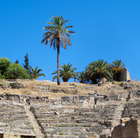Neolithic Moellia (Pacifica)
| History of Rhayna (Pacifica) |
|---|
 |
Neolithic Moellia is the archaeological period referring to the Neolithic period in the region of Moellia, starting in 11,700-8,000 BCE with the arrival of agriculture to the fertile lands of the annually flooded riverbeds and lake coasts. In the neolithic, many advancements spread, as the establishment of annual farming, and the herding of some of the first domestic animals like goats and sheep into the heights of the mountainous chains, as well as the first permanent settlements, and more elaborate forms of architecture, art, cuisine, and tool manufacturing.
Periodization
The neolithic arrived to Moellia with the spread of agriculture around the Katharistis riverbed, with signs of early agriculture tools and grain milling in around 11,700 BCE. It's unclear if agriculture developed in the region, or arrived from outside the zone from excursions or outsider civilizations. However, it's clear that as soon as it started being practised, it rapidly spread, with the last place adopting agriculture being the cultures of the north of Alla-gy in around 8,000 BCE. Usually, the neolithic in the entirety of Moellia is separated into four periods: the Early Neolithic, the Middle Neolithic, the Late Neolithic, and finally the Final Neolithic.
| Period | Approximate date |
|---|---|
| Early Neolithic | 11,700-8,000 BCE |
| Middle Neolithic | 8,000-6,000 BCE |
| Late Neolithic | 6,000-4,500 BCE |
| Final Neolithic | 4,500-3,300 BCE |
Early Neolithic
The early Neolithic period in Moellia marked a transition towards a farming-based economy. Agriculture became the livelihoods of communities, encouraging sedentary lifestyles and permanent settlements. These small settlements were composed of extended family relations, forming tight-knit communities. While farming practices flourished in most of the territory, namely Rhayna and Nea-gy, Alla-gy remained stuck in the Mesolithic, without the adoption of agriculture until 8,000 BCE. In these new settlements, communal life revolved around shared ovens built in open spaces, serving as focal points for social interaction. Moreover, this era witnessed the rudimentary development of pottery firing techniques, laying the foundation for future advancements in pottery-making.